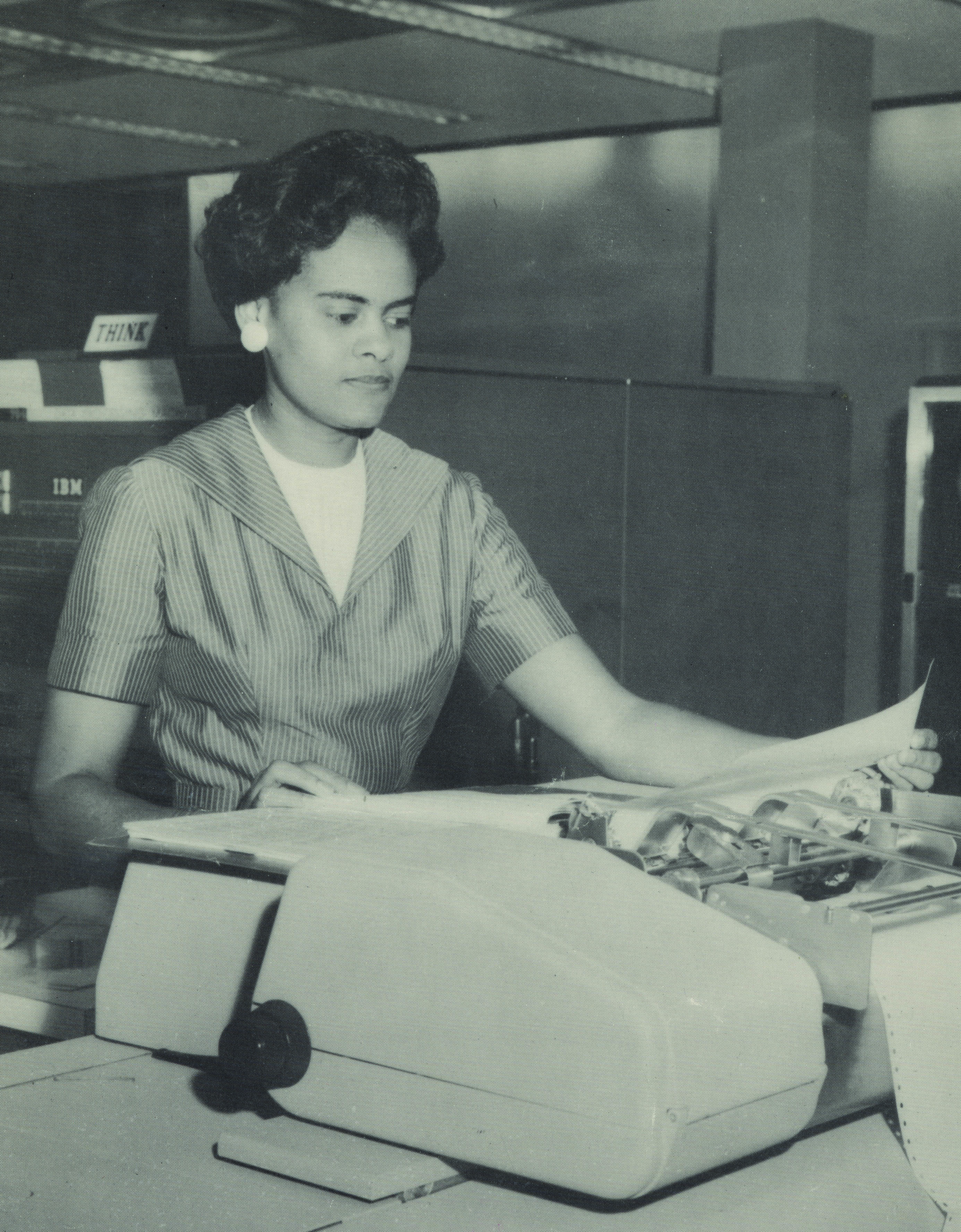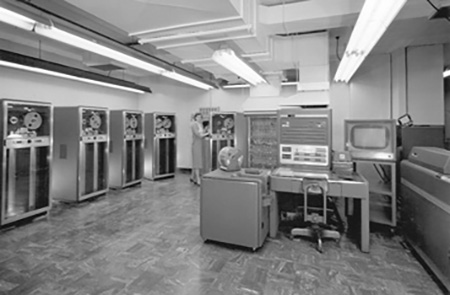A Career She “Could Not Have Envisioned”: Remembering Evelyn Boyd Granville, Mathematician and Programmer

Evelyn Boyd Granville, a renowned African American mathematician in the early Space Age, passed away on June 27, 2023, at the age of 99. This brief account of her remarkable career highlights some of her many achievements and provides further insight into her instrumental work as a programmer.
Granville1 was born in Washington, D.C., in 1924. D.C. was largely segregated until the 1950s, so she attended racially segregated public schools but enjoyed visits to museums (such as those on the National Mall) and libraries that were open to everyone. Her outstanding Black teachers at Dunbar High School encouraged and prepared her for success [3].
A studious pupil, Granville matriculated at Smith College in 1941 and focused her efforts on mathematics. She excelled there, receiving scholarships and beginning independent study in her junior year [7]. As a senior, Granville was elected to Phi Beta Kappa and qualified for associate membership in Sigma Xi; she graduated summa cum laude in 1945 with a fellowship for graduate study [3].
Granville then pursued a master’s degree and doctorate at Yale University, where she studied functional analysis under Einar Hille and wrote a thesis titled “On Laguerre Series in the Complex Domain” [2]. In 1949, she became the second Black woman to earn a Ph.D. in mathematics in the U.S.; she was one of 10 U.S. women to receive a doctorate degree in mathematics that year.
After graduating from Yale, Granville became a research assistant at New York University’s Institute for Mathematics and Mechanics (now the Courant Institute of Mathematical Sciences). She then joined the faculty at Fisk University, where she taught students including Etta Zuber Falconer and Vivienne Malone Mayes from 1950 to 1952. Next, Granville returned to D.C. and accepted a position at the National Bureau of Standards (now the National Institute of Standards and Technology), where she met mathematicians who were working as programmers and began considering a career in the field [3].
In 1956, Granville arrived at International Business Machines (IBM) with no computer experience. After a two-week training session at the Watson Computing Center, she spent a year writing programs at IBM’s D.C. office, then transferred to New York City as a research mathematician to consult in numerical analysis at an IBM subsidiary. She enjoyed the work but not the location, so when IBM opened its Vanguard Computing Center (VCC) in D.C., Granville jumped at the opportunity to relocate [3]. Doing so led to her involvement with Project Vanguard.
Project Vanguard
Project Vanguard aimed to launch a scientific satellite into orbit around Earth, prove that it had entered orbit, and use it to conduct scientific experiments. IBM won the contract for the digital satellite orbit computing facility. As a result, it supplied six weeks of use of the IBM 704 — a state-of-the-art, high-speed digital computer (see Figure 1); orbital computations for the lifetime of the satellite; the services of mathematicians for programming tasks; 100 hours of computing time; and a D.C. computing center [5].
Confirming a satellite’s orbit required tracking it through the Minitrack Network, computing its orbit, and predicting its path. Vanguard satellites contained 108-Mc signal sources. Each time a Minitrack station within the worldwide network received a transmission, it divided the transmission into phase-difference readings that were converted to direction cosines. This information was sent in triplicate to the control center, relayed by teletype to the VCC, and fed into a punch card machine. The cards were then transferred to the 704, where a master program calculated the satellite’s predicted latitude and longitude every minute up to ten days in advance [8]. The IBM system was symbolic, highly automatic, and card controlled; programming for Project Vanguard consisted of macrooperations that linked collections of subroutines with specific aims.

IBM mathematicians began programming the 704 in 1956. By the spring of 1957, IBM had used simulated observations to predict and determine a satellite’s preliminary elliptic orbit. The launch of Sputnik I in the fall provided an unexpected dry run, and the 704 successfully determined its orbit based on three accurate satellite positions.
Granville began to contribute to this project after arriving at the VCC around 1958. “At that time, the satellite was the size of a grapefruit,” she later said, referring to Vanguard I [7]. She also worked on Vanguard 2E, a weather satellite that contained photocells that produced images of Earth’s cloud cover [11].
In spite of some delays and failures, Project Vanguard met its scientific objectives. It also provided information about Earth’s shape, equator, and poles, and specified modifications of a satellite’s orbital path and rotational movement due to the Sun, Moon, and magnetic drag [5].
Project Mercury
Granville was also involved with Project Mercury, the first phase of the U.S. manned satellite program. By that point, the VCC had become the IBM Space Computing Center (SCC), and the 704 was replaced by the 709 and then the 7090: a faster, transistorized system. When NASA founded the Goddard Space Flight Center in 1959, its Computing and Communications Center featured duplexed 7090s that provided real-time position and velocity information for capsules, from launch through reentry [6].
NASA and IBM maintained joint use of the SCC until November 1960, when the mainframes were installed at Goddard. Granville left IBM (where she had become a staff assistant for trajectory problems) that same month, married Reverend G. Mansfield Collins, and moved to Los Angeles. She later described her work on Project Mercury as “one of the highlights” of her IBM career [9].
New Opportunities
In California, Granville joined the technical staff of a private company called Space Technology Laboratories (STL) [7]. Its Systems Research and Analysis Division managed space and missile system studies and housed the Computation and Data Reduction Center, where Granville worked on methods of orbit computations [3]. STL was under contract with NASA at the time, and part of its Final Report [on] Earth Satellite Orbit Computations—to which Granville contributed—discussed the Diliberto general perturbation method: a novel approach to predict the long-term motion of a near-Earth satellite that was applied to a new coordinate system to simplify analysis and results [10].
Granville left STL in 1962 for a more lucrative position at North American Aviation (NAA), whose new Space and Information Systems Division won a 1961 NASA contract to design, develop, and construct the command and service modules for Project Apollo. She became a research specialist at NAA and offered technical support to engineering departments [3]. In 1963, Granville returned to IBM as a senior mathematician in the Systems Development West Department of the Federal Systems Center (FSC). Her work included trajectory analysis and orbit computation for the U.S. Air Force’s Athena spacecraft reentry research and development program [1]. By 1966, she was a member of the Signal Analysis Department of IBM FSC-West Coast Operations, where she participated in a project for the Jet Propulsion Laboratory’s space exploration program [9].
Return to Academia
Granville and Collins divorced in 1967. Due to a simultaneous downturn in IBM government contracts, Granville returned to academia. She joined the faculty at California State University, Los Angeles (CSULA); developed an interest in mathematics curriculum standards and teaching preparation at the elementary level [4]; and coauthored a textbook on the subject in 1975.
Granville remarried in 1970 and moved to East Texas in 1984 with her husband, Edward V. Granville [3]. She retired from CSULA that year but returned to the workforce to briefly teach computer literacy and mathematics in junior high and high school, then to teach at Texas College for three years in 1985, and finally to serve as a visiting professor of mathematics at the University of Texas at Tyler in 1990. She retired for good in 1997 [7].
Recognition and Legacy
Granville’s name seldom appears in scientific publications (entire teams were credited instead), which makes it difficult to determine her individual contributions. Nevertheless, she received a number of prestigious awards and honorary degrees over the years, including the Wilbur Lucius Cross Medal from the Yale Graduate School Alumni Association as well as honors from the National Academy of Engineering and the National Academy of Sciences.
Perhaps surprisingly—given her pioneering status as a Black woman mathematician and programmer—Granville did not feel that her studies and career were marred by racism or sexism; instead, she indicated that her experiences were generally pleasant. In fact, she suggested that her success partly reflected both the dazzling rarity of women like her at the time and new opportunities for women and minorities in industry after World War II. However, Granville also acknowledged the lingering stigma that women in mathematics faced then and still face today.
In 2005, Granville reflected on her early career transition from Fisk University. “I left academia and started on a career in government and private industry that I could not have envisioned when I left Dunbar High School as a shy seventeen-year-old,” she said [4]. Granville also contrasted the opportunities for women in her youth with those in a world with personnel requirements that were engendered by World War II, the Cold War, and the electronic computer industry. “I had seen professional women solely in the position of teachers,” she said. “These were my role models. Now, I began to see women as mathematicians, engineers, chemists, biologists, [and] computer programmers” [4]. Given her trailblazing professional successes, Granville has undoubtedly served as a role model for those who have followed in her footsteps.
1 This text refers to Evelyn Boyd Granville as “Granville” throughout. She grew up as Evelyn Boyd and took the name Granville when she married her second husband.
References
[1] Equal employment opportunity – A company tradition. (1965). IBM News, 2(5), 4.
[2] Granville, E.B. (1949). On Laguerre series in the complex domain [Doctoral dissertation, Yale University]. Yale University ProQuest Dissertations Publishing.
[3] Granville, E.B. (1989). My life as a mathematician. SAGE, 6(2), 44-46.
[4] Granville, E.B. (2005). Looking back…Looking ahead. In B.A. Case & A.M. Leggett (Eds.), Complexities: Women in mathematics (pp. 272-281). Princeton, NJ: Princeton University Press.
[5] Green, C.M., & Milton, L. (1970). Vanguard: A history. In The NASA Historical Series. Washington, D.C.: National Aeronautics and Space Administration.
[6] International Business Machines Corporation and Western Electric Company, Inc. (1962). Final report, Project Mercury. International Business Machines Corporation. Prepared for NASA under Western Electric Contract MYX70005.
[7] Lamb, E. (2014). Conversations with Evelyn Boyd Granville. AWM Newsletter, 44(5), 24-48.
[8] Mowlem, A.R. (1960). The programming system for orbit determination at the IBM space computing center. In Seminar proceedings: Tracking programs and orbit determinations, February 23-26, 1960 (pp. 119-127). Pasadena, CA: Jet Propulsion Laboratory.
[9] New honor added to Dr. Collins’ accomplishments. (1966). IBM News, 3(14), 1-2.
[10] Space Technology Laboratories, Inc. (1962). Final report, Earth satellite orbit computations, part 1 (Diliberto Theory). Redondo Beach, CA: Space Technology Laboratories, Inc. Prepared for NASA under Contract No. NAS 5-1246.
[11] Weather satellite still circles Earth. (1959). Cumberland Evening Times, 90(49), 1.
About the Author
Laura E. Turner
Associate Professor, Monmouth University
Laura E. Turner is an associate professor of mathematics at Monmouth University. Her research explores the history of mathematics; in recent years, topics of interest have included the histories of women in mathematics and sexism in mathematics from the 1970s to the 1990s.
Stay Up-to-Date with Email Alerts
Sign up for our monthly newsletter and emails about other topics of your choosing.



